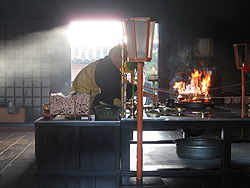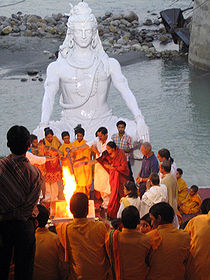
Homa (ritual)
Encyclopedia

Sanskrit
Sanskrit , is a historical Indo-Aryan language and the primary liturgical language of Hinduism, Jainism and Buddhism.Buddhism: besides Pali, see Buddhist Hybrid Sanskrit Today, it is listed as one of the 22 scheduled languages of India and is an official language of the state of Uttarakhand...
word which refers to any ritual in which making offerings into a consecrated fire is the primary action. At present, the words homa/homam and havan
Havan
Havanam is the term for a sacred purifying ritual in Hinduism that involves a fire ceremony. It is a ritual of sacrifice made to the fire god Agni. After lighting a Havan Kund , objects such as fruits, honey, or wooden goods are put into the sacred fire...
are interchangeable with the word Yagna.
Homas are an important religious practise in Hinduism
Hinduism
Hinduism is the predominant and indigenous religious tradition of the Indian Subcontinent. Hinduism is known to its followers as , amongst many other expressions...
, where they part of most of the Sanskar
Sanskar
The Samskaras , are Vedic rites of passage finding varied acceptance among religious adherents of Hinduism, Jainism and some schools of thought in Buddhism...
ceremonies, Buddhism
Buddhism
Buddhism is a religion and philosophy encompassing a variety of traditions, beliefs and practices, largely based on teachings attributed to Siddhartha Gautama, commonly known as the Buddha . The Buddha lived and taught in the northeastern Indian subcontinent some time between the 6th and 4th...
(particularly the Tibetan and Japanese Vajrayana
Vajrayana
Vajrayāna Buddhism is also known as Tantric Buddhism, Tantrayāna, Mantrayāna, Secret Mantra, Esoteric Buddhism and the Diamond Vehicle...
traditions) and Jainism
Jainism
Jainism is an Indian religion that prescribes a path of non-violence towards all living beings. Its philosophy and practice emphasize the necessity of self-effort to move the soul towards divine consciousness and liberation. Any soul that has conquered its own inner enemies and achieved the state...
.
Procedure

- the kindling and consecration of the sacrificial fire;
- the invocation of one or more divinities; and,
- the making of offerings (whether real or visualized) to them with the fire as via media, amid the recitation of prescribed prayers and mantraMantraA mantra is a sound, syllable, word, or group of words that is considered capable of "creating transformation"...
s.
The consecrated fire forms the focus of devotions; it is often maintained on specific types of dung, wood, dried coconut (copra) and/or other combustibles. The fire-altar (vedi or homa/havan kunda) is generally made of brick or stone or a copper vessel, and is almost always built specifically for the occasion, being dismantled immediately afterwards. This fire-altar is invaribly built in square shape. While very large vedis are occasionally built for major public homas, the usual altar may be as small as 1 x 1 foot square and rarely exceeds 3 x 3 feet square. Again, whereas major altars at public events may include a hollowing of the earth to create a relatively deep pit, usual altars involve no such excavation and indeed rise only inches above the ground.
In all events, the arrangement is centered in the middle of a space, which may be either outdoors or indoors. The principal people performing the ceremony and the priests who instruct them through the rituals seat themselves around the altar, while family, friends and other devotees form a larger ring around that center. The length and procedure of a homa depends on the purpose to which it is performed; many different types of homas exist, and the following list is only illustrative.
Homa ritual in Japanese Esoteric Buddhism
The Homa Ritual of consecrated fire is unique to Vajrayana and Esoteric Buddhism and is perhaps also the most mystical and cognitively powerful. It stems from the Vedic Agnihotra Ritual and is performed by qualified priests and acharyaAcharya
In Indian religions and society, an acharya is a guide or instructor in religious matters; founder, or leader of a sect; or a highly learned man or a title affixed to the names of learned men...
s for the benefit of individuals, the state or all sentient beings in general. The consecrated fire is believed to have a powerful cleansing effect spiritually and psychologically. The central deity invoked in this ritual is usually Acala
Acala
In Vajrayana Buddhism, Ācala is the best known of the Five Wisdom Kings of the Womb Realm. He is also known as Ācalanātha, Āryācalanātha, Ācala-vidyā-rāja and . The Sanskrit term ācala means "immovable"; Ācala is also the name of the eighth of the ten completion stages of the Bodhisattva path...
natha (Fudō Myōō 不動明王, lit. immovable wisdom king). The ritual is performed for the purpose of destroying negative energies, detrimental thoughts and desires, and for the making of secular requests and blessings; these are in the form of pieces of lumber with prayers written down by individuals and stamped with Acalanatha's seed syllable.
In most Shingon temples, this ritual is performed daily in the morning or the afternoon, and is a requirement for all acharyas to learn this ritual upon entering the priesthood. Larger scale ceremonies often include the constant beating of taiko
Taiko
means "drum" in Japanese . Outside Japan, the word is often used to refer to any of the various Japanese drums and to the relatively recent art-form of ensemble taiko drumming...
drums and mass chanting of the mantra of Acalanatha by priests and lay practitioners. Flames can sometimes reach a few meters high. The combination of the ritual's visuals and sounds can be trance-inducing and make for a profound experience.
Some common homas
Homa rituals have been performed by Vedic priestsVedic priesthood
Priests of the Vedic religion were officiants of the yajna service. As persons trained for the ritual and proficient in its practice, they were called '...
for several millennia. The following is an illustrative list of a few such homa rituals:
| Ceremony | Purpose | |
| Aayushya homa | to ward off evil influences present in a child's life immediately following its birth, thereby ensuring longevity | |
| Mrutyunjaya homa | for ward off life threatening situations like accidents | |
| Dhanavantri homa | for good health | |
| Durga Durga For the 1985 Hindi Film of Rajesh Khanna see DurgaaIn Hinduism, Durga ; ; meaning "the inaccessible" or "the invincible"; , durga) or Maa Durga "one who can redeem in situations of utmost distress" is a form of Devi, the supremely radiant goddess, depicted as having eighteen arms, riding a lion... homa |
to cancel negative energies; for self-confidence | |
| Chandi Chandi Chandi or Chandika is the supreme Goddess of Devi Mahatmya also known as Chandi or Durga Sapthashati. Chandi is described as the Supreme reality who is a combination of Mahakali, Maha Lakshmi and Maha Saraswati... homa |
For Victory in all endeavors | |
| Gayatri Gayatri Gayatri is the feminine form of , a Sanskrit word for a song or a hymn. Gayatri is a consort of Brahma and the goddess of learning. Brahma married her when there was a need for a companion during a yajna. Brahma had to start the yajna along with his wife... homa |
to facilitate positive thinking and subsequently performing good karma | |
| Kritya Pariharana | to counter the effects of black magic | |
| Ganapathi Ganesha Ganesha , also spelled Ganesa or Ganesh, also known as Ganapati , Vinayaka , and Pillaiyar , is one of the deities best-known and most widely worshipped in the Hindu pantheon. His image is found throughout India and Nepal. Hindu sects worship him regardless of affiliations... homa |
to overcome obstacles | |
| Lakshmi Lakshmi Lakshmi or Lakumi is the Hindu goddess of wealth, prosperity , light, wisdom, fortune, fertility, generosity and courage; and the embodiment of beauty, grace and charm. Representations of Lakshmi are also found in Jain monuments... Kubera Kubera Kubera , also spelt Kuber, is the Lord of wealth and the god-king of the semi-divine Yakshas in Hindu mythology. He is regarded as the regent of the North , and a protector of the world His many epithets extol him as the overlord of numerous semi-divine species and the owner of the treasures of... homa |
for wealth and material prosperity | |
| Mangala Samskarana homa | to celebrate auspicious events; to attain Moksha Moksha Within Indian religions, moksha or mukti , literally "release" , is the liberation from samsara and the concomitant suffering involved in being subject to the cycle of repeated death and reincarnation or rebirth.-Origins:It is highly probable that the concept of moksha was first developed in... |
|
| Mahadevi Shakti Shakti from Sanskrit shak - "to be able," meaning sacred force or empowerment, is the primordial cosmic energy and represents the dynamic forces that are thought to move through the entire universe in Hinduism. Shakti is the concept, or personification, of divine feminine creative power, sometimes... homa |
for the stimulation of a marriage and for marital felicity among those already married | |
| Navagraha Navagraha Graha is a 'cosmic influencer' on the living beings of mother Bhumidevi . In Hindu astrology, the Navagraha are some of these major influencers.All the navagraha have relative movement with respect to the background of fixed stars in the zodiac... homa |
to appease the Nine planets and limit the evil influences in one's horoscope | |
| Punyahavachana homa | for the naming of a child | |
| Sudarshana homa | for success in an undertaking | |
| Santhana Gopala homa | for blessings for a Child | |
| Rudra Rudra ' is a Rigvedic God, associated with wind or storm, and the hunt. The name has been translated as "The Roarer", or "The Howler".... homa |
Getting rid of all negative influences | |
| Vastu homa | a house-warming; to encourage good Vastu (energy in buildings) | |
| Vidya Saraswati In Hinduism Saraswati , is the goddess of knowledge, music, arts, science and technology. She is the consort of Brahma, also revered as His Shakti.... homa |
to benefit students; to facilitate learning | |
| Vishwa Shanthi homa | for universal peace and harmony, as also harmony between the self and the universe | |
| Viraja Homa Viraja Homa The Viraja Homa is a Hindu fire-sacrifice which is performed during the ceremonies whereby a Hindu monk takes up the vows of renunciation . The Viraja Homa is thus part of the full Sannyasa Deeksha .... |
purification rites performed as part of the formal ceremonies by which a person takes the vows of renunciation (Sannyas), thereby becoming a Sanyasi (monk) |
The purification rites of the Viraja homa ritual also apply to the formal ceremonies by which a Hindu monk takes up the vows of renunciation (Sannyas), thereby becoming a Sanyasi. The procedure is a part of the full Sannyas Diksha monastic initiation ceremony. After the Homa, the monk receives the ochre robes the characteristic dress of Hindu monks, from his teacher (guru).

